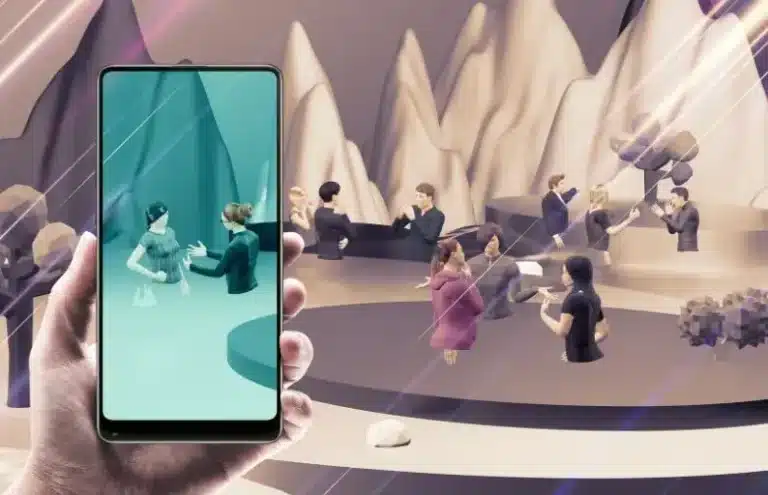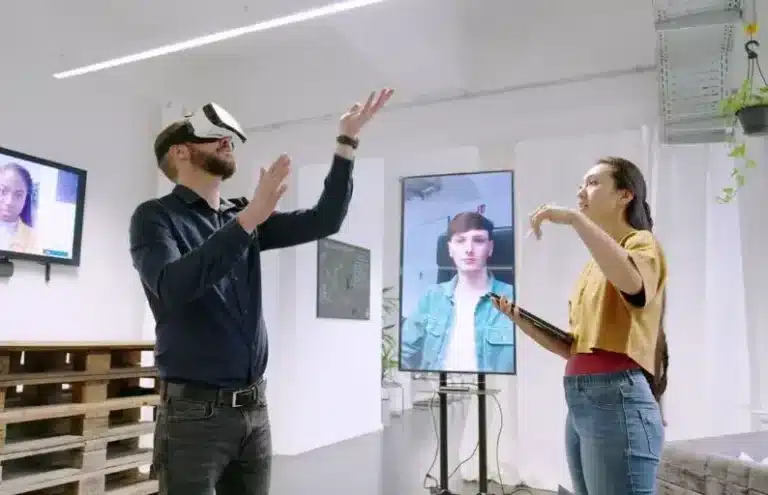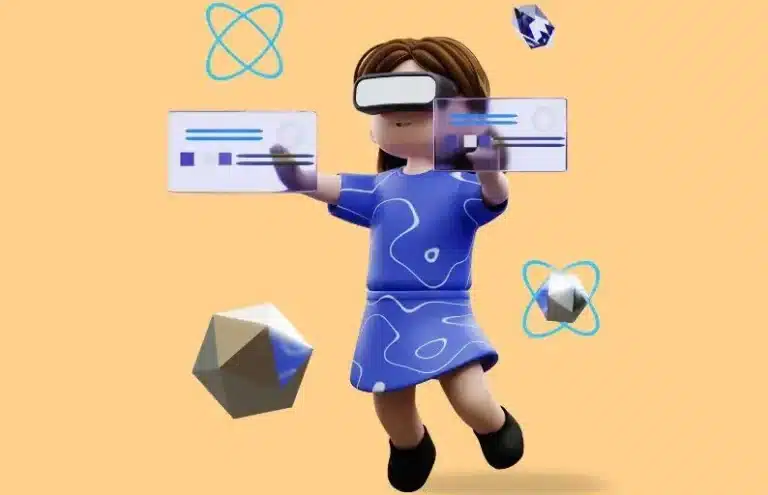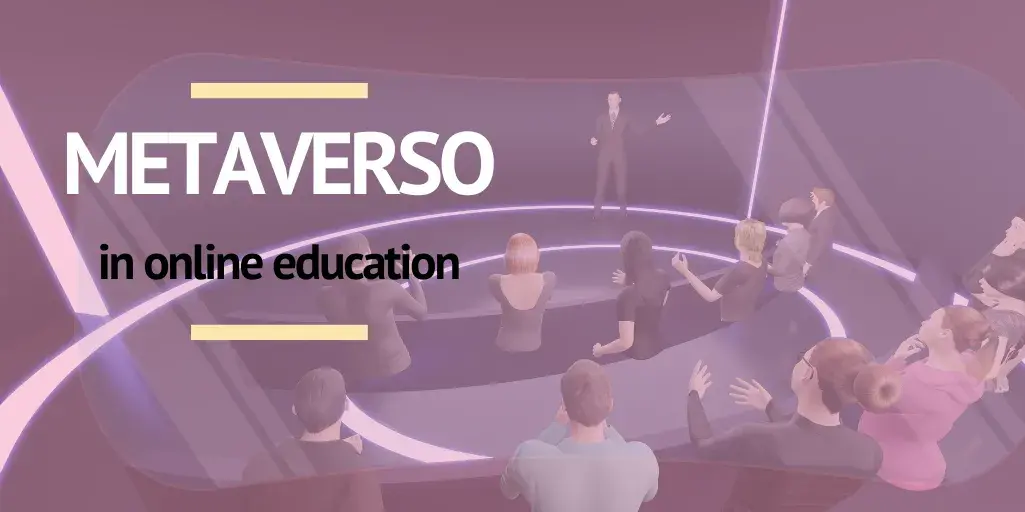Although the concept of the metaverse may sound futuristic, today it is already a real educational option that is transforming the way we teach and learn online.
Thanks to the technological advances of the last decade, elearning has evolved towards more immersive environments,
When we talk about educational metaverse, we refer to the incorporation of immersive, immersive and personalised technologies in education, such as virtual reality (VR) in education or augmented reality.
In this article we tell you how the metaverse, with the virtual reality in education, is revolution this, the benefits of metaverse in education, its applications in elearning platforms, its current challenges and how can virtual reality be used in education.
What is the metaverse in education?

The education in metaverse is an immersive and interactive digital environment where students can interact with each other, live realistic metaverse learning experiences and simulations, and learn in a three-dimensional virtual space.
Unlike virtual reality in education, which tends to focus on individual experiences or closed simulations without many options for interaction or expansion, the educational metaverse allows students to access shared learning spaces to expand their knowledge and experience first-hand the theoretical concepts learned.
It also differs from traditional gamified environments, as these generally focus on game dynamics, with rewards and achievements without any pedagogical purpose.
Benefits of the education in metaverse

Using the latest metaverse technologies in education not only modernises teaching, but also has advantages in terms of improving students’ attention, active participation and retention of information.
Some of the benefits of the education in metaverse include:
Enables immersive learning
Generates greater engagement and motivation
The fact that it is interactive and customisable increases interest and motivation on the part of students. For example, when metaverse and education come together to turn a biology class into a virtual 3D exploration of the human body, where students interact with the organs.
Promotes global collaborative learning
It can simulate professional environments
Work environments can be recreated to promote X-Learning and to carry out safe and realistic practices without having to travel to a facility. For example, future doctors can perform surgical practices in virtual simulators before moving on to real scenarios.
Adapts to the pace of the learner
Content can be adjusted according to each learner’s progress and learning style, and provides more freedom to explore the environment at their own pace, such as a history student exploring different periods by travelling back and forth in time, accessing information according to their curiosity.
Breaks down physical and economic barriers
Physical barriers are eliminated by not having to travel and the costs of purchasing physical materials are reduced. For example, a laboratory where experiments can be carried out without any real risk and without having to invest in laboratory machinery or chemical compounds.
Metaverse tools for teaching online

For teaching in the metaverse to be effective, it is important to have specific technologies to create and manage these immersive environments. Today, there are multiple virtual reality tools for education that facilitate metaverse online learning, from metaverse virtual classroom platforms to specialised simulators.
- Immersive virtual classroom platforms: these are digital spaces where teachers and students interact in real time with avatars, such as Virbela, which makes it possible to create entire campuses to encourage connection between students even if they are hundreds of kilometres away.
- Educational 3D resources: three-dimensional models allow complex concepts to be visualised in an interactive and tangible way, as well as allowing elements to be enlarged and rotated for better understanding, such as anatomical models or molecular structures.
- Virtual reality tools for education and the creation of interactive content: there are some applications that allow the design of customised educational experiences within the metaverse, such as Unreal Engine
- Simulators and virtual laboratories: tools such as Labster create realistic and safe environments to practice technical, scientific or medical skills without risk.
- Immersive access devices: the experience would not be fully immersive without physical technology to enhance it, such as the virtual reality goggles and haptic controllers of the Meta Quest 3.
Metaverse applications in online education
Due to its multiple advantages, the metaverse is a very versatile tool that is already being applied in different contexts and areas of online education:
Civil service examinations and regulated training
Online academies for civil service examinations are booming, and with it the use of formats that allow the replication of environments where candidates or students of official education can interact with the content and practice in realistic situations. For example, an education exam candidate can experience a simulated class with virtual students to prepare for the practical part of the exam.
Vocational and technical training
Immersive environments are ideal for training in practical skills without the need for large investments in physical infrastructure and operational risks. Very useful in situations such as training centres and VET students practising the installation of electrical systems in a 3D environment before moving on to actual implementation.
Language learning
The metaverse facilitates full language immersion by allowing the simulation of real-life contexts, e.g. it opens up the possibility of entering a virtual supermarket in London to interact with customers and employees and practice vocabulary in a real-life situation.
Business soft skills
In-house online training on leadership, conflict management or business ethics is common in companies. The metaverse allows employees to take on different roles anonymously within the company and solve a problem as a team.
How to use the metaverse in online classes?

You might wonder, how can virtual reality be used in education? Using the metaverse for virtual classes does not mean having to redesign the entire course, but rather adapting the methodologies to a new, more dynamic and immersive environment. The aim is not to replace the teacher, but to expand the possibilities.
You should first identify which topics or competences could benefit from a virtual experience such as a simulation or a collaborative activity. Then, when designing the learning experience, think about what the learner will have to do within the virtual environment, what scenarios it should include and what the ultimate goal is.
Then select a metaverse tool that aligns with your needs and allows you to integrate it into your LMS. It combines immersive elements, such as VR and education, with classic e-learning elements, such as quizzes, forums, or downloadable content.
Finally, make sure learners understand how to access the environment, use their avatars and what is expected of them during the lesson. Finally, evaluate participation and learning, not only the knowledge acquired, but also collaboration, interaction and the ability to adapt to the metaverse to assess its effectiveness.
Examples of metaverse in online education
- Stanford University's Virtual People subject: a subject taught entirely in the metaverse using virtual reality glasses
- The Space Classroom at the University of Murcia: a classroom where students from different areas can practice their technical skills, from architecture to medicine.
- Digital Twin Campuses by Meta + VictoryXR: Meta and VictoryXR designed virtual replicas of real universities, such as Morehouse College, where students can attend classes and complete courses virtually.
- eXp Realty: this is a real estate company that also operates in the metaverse, where employees meet, attend lectures and access training.
What are the disadvantages of metaverse in education?
Although the metaverse represents a revolution in the way we teach and learn, its implementation is not without barriers. For many educational institutions, the leap into immersive environments involves technical, economic and ethical challenges.
- Digital divide: althoug e-learning serves to bridge the digital divide, it is true that not all students have high-speed connections or the appropriate devices to access the educational metaverse.
- Implementation costs: the development of the spaces, the purchase of the necessary hardware and training may involve a high initial investment that not all institutions can afford.
- Learning curve: Because the technology is more advanced, both teachers and students must learn to use and navigate these environments, which may require frequent initial technical support.
- Risk of overstimulation: if the environment is not well planned or designed, it can divert attention from the main objectives.
- Privacy and data security: the use of these virtual tools raises concerns about data collection and digital identity protection. The RGPD must be complied with.
- Lack of clear pedagogical standards: there are still no official standards on how immersive experiences should be designed, delivered and evaluated. This leads to the fear that the content will not be officially recognised or the courses will not translate into academic credits.
The future of education in the metaverse

The metaverse in education is here to stay and, although it is still in very early stages and must overcome some challenges, the true potential of the metaverse in education is yet to be defined in the coming years.
The impact of the metaverse just like VR and education on learning is undeniable, although everything points to the fact that it will not completely replace the traditional classroom, but will complement it with immersive, more active and participatory experiences. We are heading towards a hybrid educational model, where the face-to-face, the virtual and the immersive will coexist to offer more flexible and personalised learning.
We can imagine some changes and new trends that could occur in the near future, such as the presence of holographic teachers in classrooms, classes taught by artificial intelligence with avatars capable of adapting to the level of each student and offering personalised tutorials and persistent virtual environments that students can access even when they are not in class to meet with their classmates in the library or virtual cafeteria.
